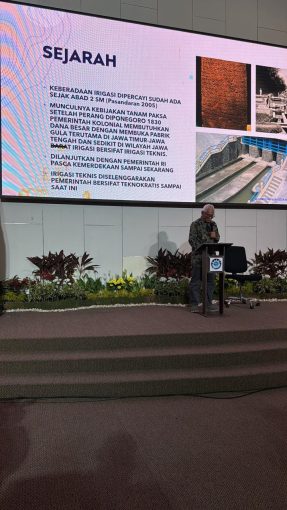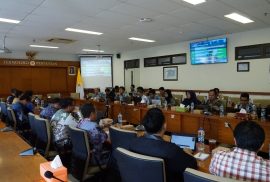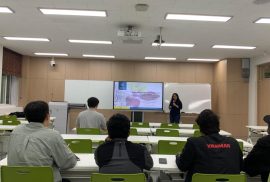
Manado, October 18, 2025 — Prof. Dr. Ir. Sigit Supadmo, M.Eng., Professor of Irrigation Engineering at the Department of Agricultural and Biosystems Engineering, Faculty of Agricultural Technology, Universitas Gadjah Mada (UGM), served as a keynote speaker at the Annual Scientific Meeting of the Indonesian Hydraulic Engineering Association (HATHI) held at Sam Ratulangi University, Manado. In this session, Prof. Sigit delivered a presentation titled “Optimization of Water Use for Agriculture to Support Sustainable Food Self-Sufficiency.”
In his opening remarks, Prof. Sigit reviewed the evolution of irrigation management—from the era of kingdoms, through the colonial period, to the post-independence era—highlighting the paradigm shifts that have emerged as intellectual responses to empirical phenomena showing misalignment between development implementation and outdated paradigms. According to him, this shift demands a renewed perspective in the direction of policy and water resource management practices.
To address these challenges, Prof. Sigit introduced five pillars of irrigation modernization as the foundation for optimizing irrigation toward achieving food self-sufficiency:
-
Water availability
-
Infrastructure
-
Management
-
Institutional framework
-
Human resources (HR)
These pillars encompass water conservation and optimal utilization, mitigation of hydrometeorological risks such as floods and droughts, provision of accurate data and information, and empowerment of all stakeholders—farmers, government, and the private sector. Prof. Sigit emphasized that the focus of food self-sufficiency programs must be human-centered, built on intellectual capital rather than infrastructure alone.
Reflecting on historical experiences, Prof. Sigit revisited the 1984 food self-sufficiency strategy, which relied on legal frameworks (e.g., Law No. 11/1974), infrastructure development, production centralization, and bureaucratic mobilization. However, these efforts faltered due to several constraints—funding limitations, climate change, failure of the trickle-down effect policy assumption, and the absence of effective public-private participation (PPP). Policy turbulence in subsequent administrations, he noted, further contributed to uncertainty among irrigation practitioners.
Prof. Sigit also discussed the recent policy shift from mere infrastructure development toward accelerated rehabilitation of irrigation networks, including tertiary channels—considered the most problematic—along with the importance of inter-ministerial coordination to reduce long-standing sectoral egos that often hinder implementation.
In assessing irrigation performance across Indonesia, the government has introduced IKSI (Irrigation System Performance Indicators), which evaluate various aspects including infrastructure, crop productivity, supporting facilities, organization and personnel, documentation, and farmer water user associations (P3A). Findings show that many regions still perform below the desired level, prompting the need for stronger involvement and intervention from local governments.
Before concluding, Prof. Sigit underscored that the emergence of Industry 4.0 and digital transformation is inevitable, and these advances must be harnessed in irrigation and agricultural modernization efforts. He cited several digital initiatives, including SMOPI, E-PAKSI, and SIPASI ver.2—jointly patented systems between the Ministry of Public Works and Housing (PUPR) and UGM—which have been implemented at sites such as Tabo-Tabo (BBWS Ponjen) and Kedungputri (BBWS Serayu Opak). Furthermore, capacity building for field operators is being strengthened through the Knowledge Management Center (IKC) as part of ongoing collaborative patent development.
In his closing remarks, Prof. Sigit delivered a strong critique, calling on the government to reduce its overreliance on infrastructure-based management (infrastructuralism) and instead give greater attention to human resource empowerment, institutional strengthening, and the welfare of operational (O&P) personnel. He highlighted several key concerns:
-
The operation and maintenance (O&M) budget remains very low—only about 35% of the actual needs (AKNOP) in 2023–2024;
-
Budget efficiency policies have negatively impacted staff status, welfare, and capacity development;
-
Regulatory shortcomings, such as PUPR Regulation No. 12/2015, which focuses mainly on staff obligations without ensuring rights or employment status;
-
Insufficient recognition of farmers’ roles in policy formulation; and
-
The lack of legal guarantees for irrigation personnel, leading to job insecurity and welfare disparities.
Prof. Sigit stressed the irony of pursuing food self-sufficiency while the welfare and legal status of key irrigation workers remain uncertain. He concluded that achieving sustainable irrigation optimization requires more than physical infrastructure—it must rest upon strong institutions, capable human resources, and inclusive governance.
Relevance to the SDGs. Prof. Sigit’s insights and recommendations directly align with several Sustainable Development Goals, particularly SDG 2 (Zero Hunger) through strengthened food security, SDG 9 (Industry, Innovation, and Infrastructure) via the advancement of irrigation innovation, and SDG 4 (Quality Education) and SDG 8 (Decent Work and Economic Growth) through human capacity development and improved workforce welfare.
Prof. Sigit’s presentation at PIT HATHI 2025 opened an important discourse for future policy and practice in irrigation management—emphasizing that true optimization must integrate technology, institutions, and human investment to achieve sustainable national food self-sufficiency.




